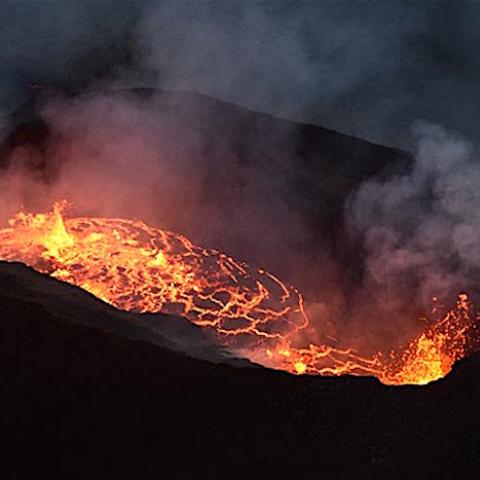
A land collapse at Hawai'i Volcanoes National Park sent a large plume of gas, ash, and steam into the air on New Year's Eve/NPS, Travis Delimont
A large section of newly created land in Hawai‘i Volcanoes National Park collapsed into the ocean on New Year’s Eve, launching showers of volcanic rock into the air and creating a flurry of large waves that eroded away a portion of the older sea cliff and viewing area, leading to “a really close brush with death” for five visitors.
As a result of the collapse within the 26-acre lava delta formed by the “61g” lava flow, the Kamokuna ocean entry will remain closed until it is determined safe to reopen. Park rangers and USGS Hawaiian Volcano Observatory scientists surveying the area on New Year’s Day reported that the former viewing area is gone and that loud cracks continued to be heard throughout the unstable area. The County of Hawai‘i also closed the Kalapana access to the park.
“Fortunately, there were no aircraft or boats reported in the area at the time of the collapse, nor were any visitors on the delta itself, which is closed for public safety,” said park Superintendent Cindy Orlando. “Had anyone been close by on land, water, or air, lives would have surely been lost.”
Five visitors who ignored the closure, however, likely only survived due to pleading from park rangers. After the viewing area had been roped off, a group headed to the coastal cliffs around 7 p.m. on New Year’s Eve. Eruption Crew Ranger Travis Delimont and a co-worker chased after them before they turned around. Within 15 minutes, the section of cliff where the visitors were standing crashed into the ocean.
“It was a really close brush with death for them,” Ranger Delimont said. “Luckily, they finally listened to us and turned around in time.”
Lava deltas are extremely hazardous volcanic features and are formed when lava enters the ocean and builds new land on loose and unstable substrate. In addition to the threat of collapse, lava entering the ocean produces a highly corrosive plume of hydrochloric acid and volcanic particles that irritate the lungs, skin, and eyes. Visitors are strongly urged to stay out of closed areas and heed all posted warning signs.
There is a temporary flight restriction of 1,000 feet above ground level at the Kamokuna ocean entry.



 Support Essential Coverage of Essential Places
Support Essential Coverage of Essential Places







Comments
When we were there in Kalapana in the summer of 2016, Park Rangers REGULARLY warned tourists about dangers of fresh and even old lava flows. They were relentless but polite and friendly as they know the danger is real. LISTEN to the Park Rangers as they quite obviously save lives. In addition they are also extremely helpful and knowledgeable and so are great people to ask for help. Thanks you guys!
I fully agree with the previous comment. Park rangers are performing a great job to ensure the visitors' safety.
E Pele, eia ka 'ohelo 'au;
e taumaha aku wau 'ia 'oe
e 'ai ho'i au tetahi.